Sulfate-free shampoo is a type of shampoo that does not contain sulfate salts, such as sodium lauryl sulfate, sodium lauryl ether sulfate or ammonium lauryl sulfate, and is recommended for dry, fragile or brittle hair because it does not harm the hair as much as a regular shampoo.
The sulfate salts in shampoo are detergents responsible for creating foam and cleaning the hair and scalp more deeply, removing their natural oils. However, these salts can make hair dryer and more brittle, and in more sensitive people, it can cause irritation or itching on the scalp.
In this way, sulfate-free shampoo, also known as shampoo low poo or shampoo no poocleans the hair, maintaining the scalp’s natural oils and preventing dry hair, and can be found in supermarkets, pharmacies or drugstores, in different brands.

What is it for
The sulfate-free shampoo is used to clean the hair, without drying out the strands and maintaining the scalp’s hydration and natural oils. Furthermore, this shampoo prevents allergies or scalp irritation in more sensitive people.
This is because sulfate-free shampoos do not contain sulfate salts in their composition, which have a detergent action. This way they do not form foam and do not remove the natural oils from the hair and scalp, cleaning without damaging the strands.
When is indicated
Sulfate-free shampoo is recommended in the following situations:
- Dry or parched hair;
- Fragile hair;
- Curly or frizzy hair;
- Chemically treated hair, with straightening, progressive brushing or dyes;
- Frizzy hair;
- Scalp allergies.
Furthermore, as it does not contain sulfates in its composition, which has an intense detergent action, the sulfate-free shampoo helps maintain the color of dyed hair, leaving it less faded.
How to choose
Sulfate-free shampoo generally contains natural active substances, such as coconut oil, honey, arginine, murumuru butter or red and brown algae, which do not harm the strands and maintain hair hydration.
Some examples of sulfate-free shampoo are:
- Low Poo Botica Cachos Perfeitos Bio Extratus Shampoo;
- Natura Lumina Low Poo e No Poo;
- Lola Cosmetics Smooth, Light and Loose Shampoo;
- Shampoo Low Poo Dr Ricino Novex;
- Shampoo Beauty Care Less Poo Yamasterol;
- Truss Curly Low Poo Shampoo;
- Deva Curl Shampoo Low Poo Original.
These shampoos can be found in supermarkets, pharmacies, drugstores or beauty salons, labeled low poo shampoo or low poowhich means low amounts of sulfate, or no-poo shampoo, which does not contain any amount of sulfates.
In any case, it is recommended to always read the shampoo label to check if it says “does not contain sulfates”, “low sulfates” or “zero sulfates”, for example.
What is the difference between salt-free shampoo and sulfate-free shampoo
Salt-free shampoo and sulfate-free shampoo are not exactly the same thing because although these two substances are salts that the cosmetic industry adds to shampoo, they have different functions.
Salt-free shampoo refers to the removal of sodium chloride from its composition, which is good for those with dry or parched hair, because it leaves the hair dry and causes irritation or flaking on the scalp, especially those with fine hair. curly or frizzy.
Sulfate-free shampoo does not contain sulfate salts in its composition, such as sodium lauryl sulfate, sodium lauryl ether sulfate or ammonium lauryl sulfate, which are another type of salt that also dries out the hair.
Therefore, those who have thin, fragile, brittle, dull or dry hair can choose to buy salt-free shampoo or sulfate-free shampoo, because it will benefit them.

Sign up for our newsletter and stay up to date with exclusive news
that can transform your routine!
Warning: Undefined array key "title" in /home/storelat/public_html/wp-content/plugins/link-whisper-premium/templates/frontend/related-posts.php on line 12
Warning: Undefined array key "title_tag" in /home/storelat/public_html/wp-content/plugins/link-whisper-premium/templates/frontend/related-posts.php on line 13




